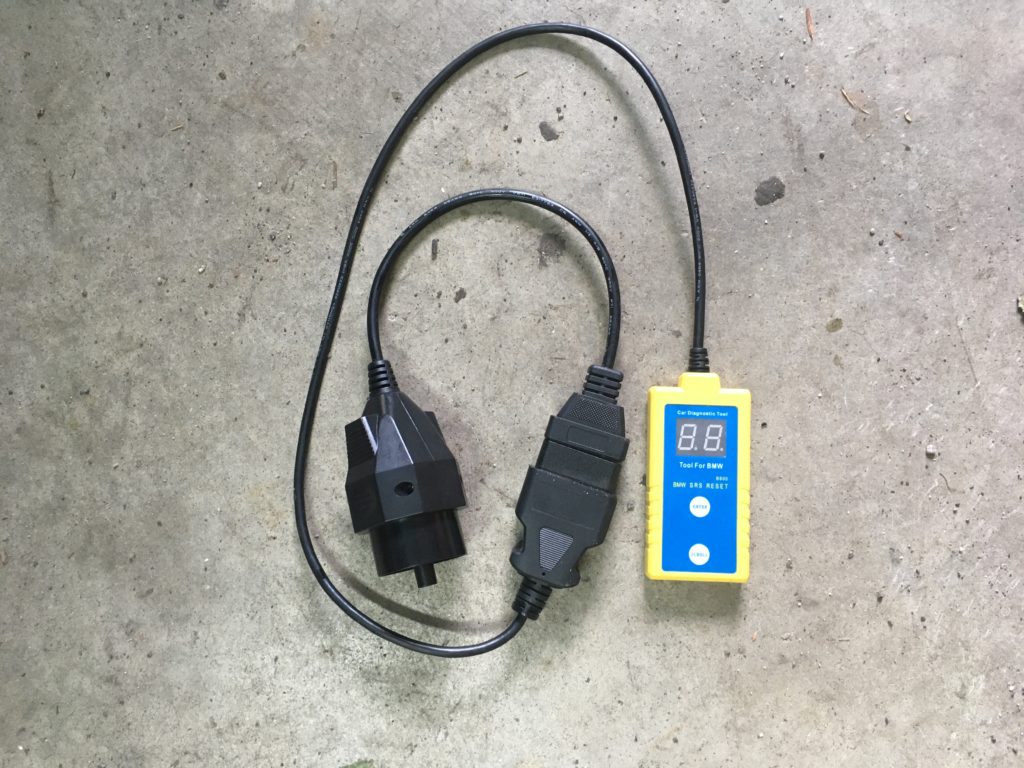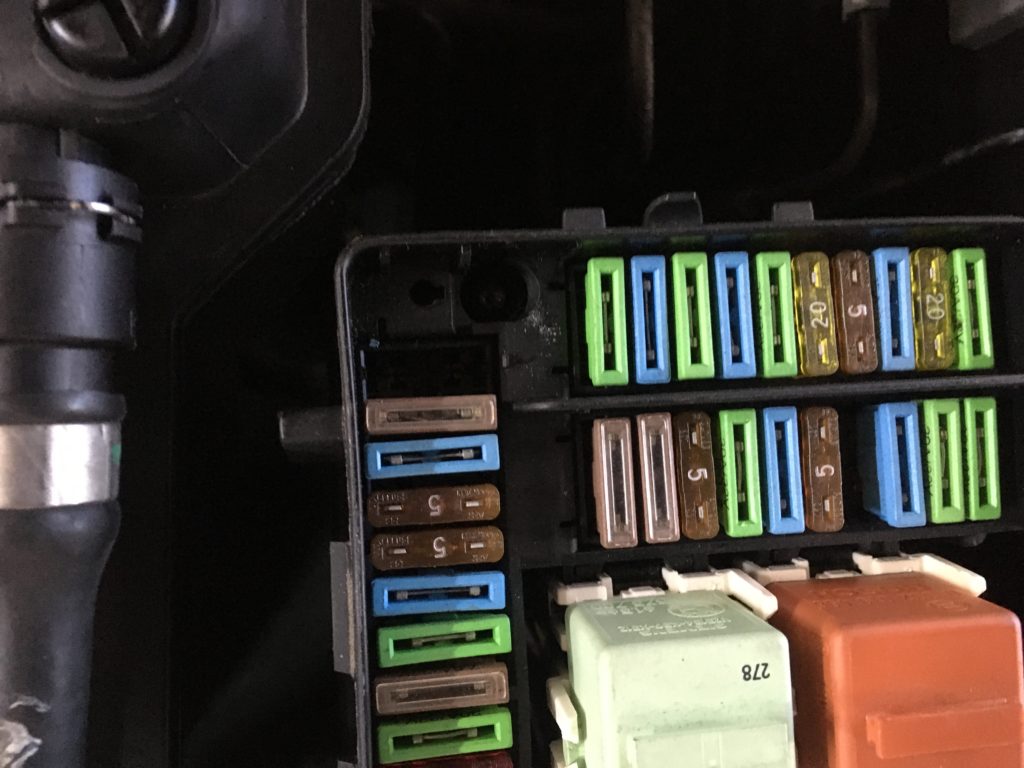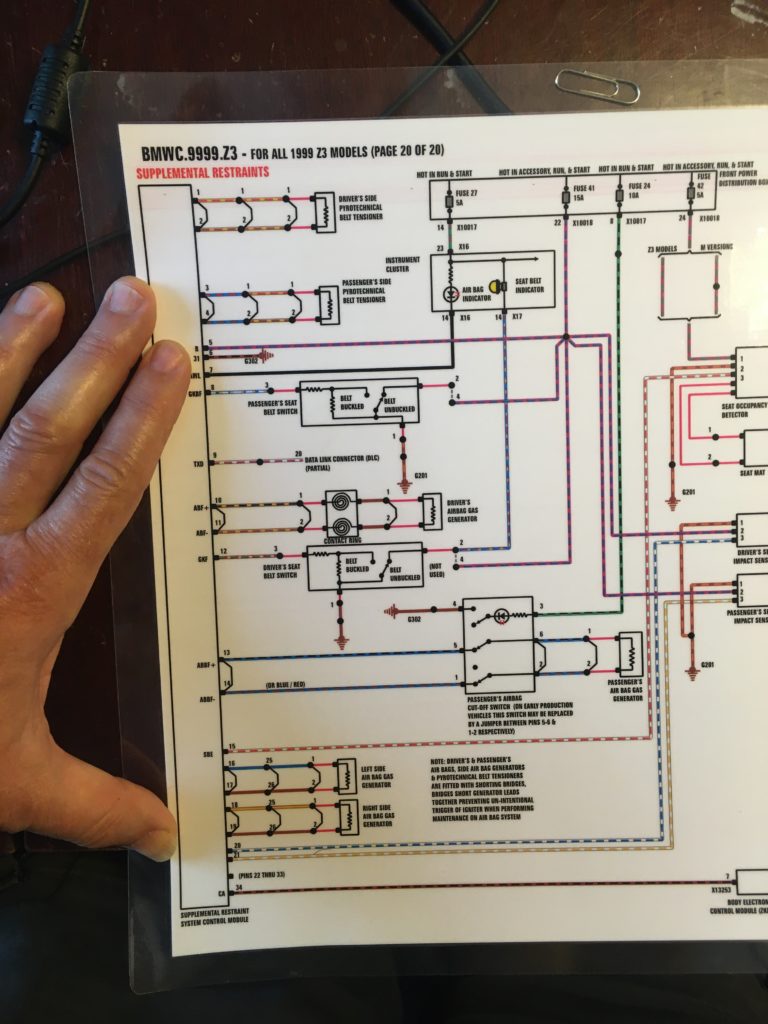As I’ve written many times before, a “good kluge” is one that saves money, is safe, and can easily be undone. We can have a debate over whether or not I describe below is a good kluge or an ugly hack. The fact that my inner lawyer requires that I say, “It’s what I did, but don’t do it” probably tips it into the latter category.
I think it’s best looked at as something horrifying but interesting, like insects that lay eggs in other insects’ brains.
My last task before returning Zelda, my former 1999 Z3, to my friend and neighbor Kim (her current owner) was to get the car inspected. Unfortunately, the Supplemental Restraint System (SRS) light was on. This was a problem: Massachusetts state inspection law says that although they only plug the service computer into the OBD-II port, check for “ready” status, and do a tailpipe-emissions test on cars older than ten years old, if any of the emissions or safety-related dashboard indicators are on—and that includes the Check Engine light, the brake-pad-lining light, the ABS or traction-control light, and the SRS light—it’s an automatic inspection failure.
I’d had problems over the years on both Zelda and my 1999 Z3 M coupe with the SRS light occasionally coming on. When it did, I’d plug in my B800 SRS code reader—a cheap Chinese knock-off of the Peake Research SRS tool that I bought years ago—and pull the code, and it would invariably show the code was due to a failure in one of the seat-belt tensioners. This is a fairly common problem, often caused by a poor connection. I’d re-seat the connector and clear the code, and the problem wouldn’t come back for months or years.

My B800 SRS tool.
But not this time. Instead, the tool reported “data line error” codes for both left and right door airbags. I searched online for information on what the codes meant—and to find a solution to the problem—and did not find anything as quick and easy as unplugging and plugging under-seat connectors, as I’d been doing, or even a description of what the likely root cause was. People talked about replacing the airbag-control module and rebuilding the part of the wiring harness that runs under the seat. If it was my car, I might have gone down this slippery slope, but all I was trying to do was get the car inspected as a favor before returning it to Kim.
I wondered how difficult it might be to simply shoot the messenger and make the SRS warning light go out, either by removing the bulb or fiddling with the wiring, or—the holy grail of hack simplicity—by pulling a fuse. I did some web sleuthing and found a tantalizing video of a guy who described pulling the fuse and extinguishing the SRS light on his E46.
Giddy with the possibility, I ran out to the garage, popped the fuse cover, and looked at the labels and numbers on the underside. One by one, I pulled each fuse that listed “airbag” or “instrument cluster.” But none of them made the SRS light go out. Damn.

I pulled fuses. The SRS light stayed on.
But then I noticed that I had missed one. I yanked Fuse #41, and the SRS light went out. Wonder of wonder! Miracle of miracles!
Okay, then: a quick pre-inspection test and I’ll drive down and get the sticker. Headlights, high and low beams, check; wipers, check; horn, check; directionals, check. (For the rear lamps, I’ve learned to position the car just inside the garage and roll down the door; that way I can see the reflection of the lights on the inside of the door.) Reverse lights, check. Brake lights—
Brake lights. I said brake lights!
Damn.
Mystified, I put Fuse #41 back in, and the brake lights sprang to life.
Double damn.
Well, I thought, obviously the brake lights must draw power from Fuse #41. If I can just disconnect the power for the SRS light from #41 and leave the brake lights connected, I’ll be all set. I unhooked the battery, unscrewed the fuse box from its base, lifted it up, and saw four power wires going to the hot side of Fuse #41, but only a single purple-and-yellow-striped wire coming off the output side of the fuse.
It’s never easy, is it?
Obviously, for this tack to be successful, I needed to understand how the SRS and brake light were sharing power.
Before I go another step further, let me say something. I, who spent a year and a half of my life writing The Hack Mechanic™ Guide to European Automotive Electrical Systems when I was working for Bentley Publishers, hate reading wiring diagrams—seriously. Back in the good old days, when cars were simple, wiring diagrams fit on a single page, maybe a double fold-out, and actually showed real wire paths. They were even drawn in relation to where they were on the car: headlights at the top of the page, taillights on the bottom, and so forth.
But as we entered the mid-1970s, safety standards and emission controls complicated not only the cars but their wiring diagrams, making it impossible to fit them on a double page and be readable. But that was nothing compared to what was to come—first electronic fuel injection and all of its sensors, then OBD-II and cars with multiple control modules and data buses. The wiring diagram of any post-1995 OBD-II car so complex that it’s no longer reproduced on a single or a double sheet of paper; it can’t be. Instead, what you get is sections of it. One section might be power distribution; another might be ground points. There’s a section just for digital engine management, another for lighting, and another for climate control. You get the idea.
Because of this level of complexity, it can be very difficult to see the connections between different systems. When I have electrical issues, I try to figure things out by looking on forums for most-likely causes (it’s rare that you’re the first person experiencing a problem), assuming that it’s rare for wires to break in the middle of a harness (unless it’s something that moves, like a power seat or a rear hatch), gleaning valuable information by poking around with a multimeter, and only resorting to wiring diagrams as a last resort.
However, by sheer coincidence, my friend Doug Jacobs, the force behind Prospero’s Garage and colorwiringdiagrams.com, had sent me Prospero’s Z3 wiring-diagram set. Prospero’s wiring diagrams are great; I have them for multiple cars. They’re specific to the year of your car, they’re printed on multiple laminated 11″-by-17″ sheets, they’re in color, and both the text and the graphics are large and easy to read. The Z3 set covers both sides of ten sheets, so it took a bit of poking around to find the sheet with Fuse #41 on it.

The ten laminated sheets in Prospero’s Z3 wiring-diagram set.
The diagram showed only SRS-related components fed by a single wire coming off Fuse #41, which jibed with what I saw with my own eyes when I lifted up the fuse box.

My index finger is pointing to Fuse #41, my thumb to the SRS-related components.
Figuring that since I saw only one wire coming off the hot side of the fuse, the power to the brake lights must be coming through some other path, such as a control module, I looked further in the wiring-diagram sheets, and found this blowup of the wiring for the SRS control module. But if it showed a path to the brakes, I couldn’t see it.

Not there, either.
Next, I looked at the wiring diagram for the brake-light switch. It was depicted as a double-pole single-throw switch getting power from both Fuse #13 and Fuse #46, but not Fuse #41. Wherever the power was coming from, it was subtle.
Although, if I have to consult a wiring diagram, I prefer the laminated Prospero’s diagrams with their big easy-to-read color symbols to trying to read off a computer screen, I searched online and found a copy of the BMW Electronic Troubleshooting Manual (ETM) for the car. It appeared to agree with the Prospero’s diagrams: How power was getting from Fuse #41 to the brakes was a mystery.
I suppose that I could’ve abandoned this path entirely and tried to trace the data-line error itself, or tried to extinguish the bulb in the instrument cluster, or to cut the line to that bulb, but I thought that I was hot on the trail. Having identified linked power between the SRS warning and brake-light systems, how hard could it be to separate it and power one but not the other?
I looked at the brake-light switch. This meant pulling off the panels that I’d removed and reinstalled when replacing the accelerator-pedal grommet in last week’s episode. I put my hands on the brake pedal, felt upward, found the switch, and pulled the connector off. As depicted in the wiring diagram, the connector had four wires. There wasn’t much slack on the cable harness, so I needed to work while crouching down and reaching up.
I set my multimeter to measure voltage. With the ignition on and Fuse #41 inserted, I probed all four pins in the connector. I found that Pins #1 and #4—the outside two pins—had voltage. Then I removed Fuse #41 and rechecked. Pin #4 still had voltage, but Pin #1 didn’t. Therefore Pin #1 must be the one being fed power somehow from the SRS.
Gotcha!
So, in theory, if I pulled Fuse #41, disconnected the wire to Pin #1, and powered it instead by something unconnected to the SRS in any way, I’ should have the SRS light out and the brake lights still working, which was what I needed to get the car inspected. Unfortunately, “disconnect the wire” meant “cut the wire” (well, “cut the wire and splice a connector into both ends so it can be reconnected”), and there’s the rub: I knew that the wire had a connection to the SRS, which is a safety-related system, and it wasn’t my car.
Now, at this point, I had a theory that I couldn’t prove: I recalled from a BMW seminar decades back that when you stand on the brake pedal, the SRS knows that an accident may be imminent, and decides to pull the seat-belt tensioners tight. If this is true (and I don’t know if it is), it would explain why there was a connection between the two systems. I also noted that there are other fuses listed for the airbag and SRS, so I thought it likely that in cutting this wire, I was only disabling the belt-tension system (which might not have been working anyway—after all, what was causing me to go to all this effort was that the SRS light was on), or the tensioners and the side airbags, but not the one in the steering wheel—but again, I wasn’t sure.
All of which is why you shouldn’t do this. (Seriously.)
I spoke with Kim and explained all this, and how I thought I could make Zelda’s SRS light go out for inspection, but it meant temporarily cutting the SRS wire. “I trust you” was the response. Trust is a wonderful and terrible thing.
Now, remember that this is all a favor for a friend; I’m trying to get the car legal so that she can enjoy it through the fall. But in doing something like this, it’s reasonable to ask What about the next owner? Well, as I said last week, the next owner is likely to be me (it’s likely that I’ll wind up buying Zelda back), so I’ll have the chance to delve into the root cause of the problem, given more time.
So I cut the wire and immediately spliced a male spade connector onto one end and a female onto the other so that I can reconnect them later. Then I had to power Pin #1. First, as a test, I ran a long wire from the spade connector on Pin #1 directly to the battery, and plugged the four-pin connector back into the brake switch. With Fuse #41 still removed, I started the car and hit the brake pedal. It worked: The brake lights went on, and the SRS light was still off.
Next I had to power Pin #1 by a method more elegant than running a cable to the battery. Since Pin #4 was also powered, I decided that the simplest way to do it was to temporarily run a short jumper wire from Pin #4 to Pin #1, inserting it into the back of the connector. I installed and tested it, and it worked.

You can see the spade connector on the wire that originally powered Pin #1. The orange wire is the temporarily-installed jumper wire from Pin #4 to Pin #1. I did seat the wire into Pin #4 better after this photo was taken.
It wasn’t pretty, but it was successful at shutting off the SRS light while keeping the brake lights working.
Save money? Definitely. Easily undone? Just pull out the jumper and connect the two spade terminals. Safe? Well, I can justify it as a temporary fix to get the car through inspection, after which it’ll be removed, and the car will be no worse than before, with the SRS light on, and awaiting a real diagnosis. As I said, this is best regarded as a Jurassic Park-like exercise in what’s possible but not advisable. I vote ugly hack. Don’t do it.
So, after all that, did I get the car inspected? Not yet. Why? Because the registration is missing. Grrr.—Rob Siegel
Rob’s most recent book, Resurrecting Bertha: Buying Back Our Wedding Car After 26 Years In Storage, is available here. on Amazon. His other books, including Just Needs a Recharge: The Hack MechanicTM Guide to Vintage Air Conditioning, are available here on Amazon. Or you can order personally inscribed copies of all of his books through Rob’s website: www.robsiegel.com. His new book, The Lotus Chronicles, will be available in the fall.





















